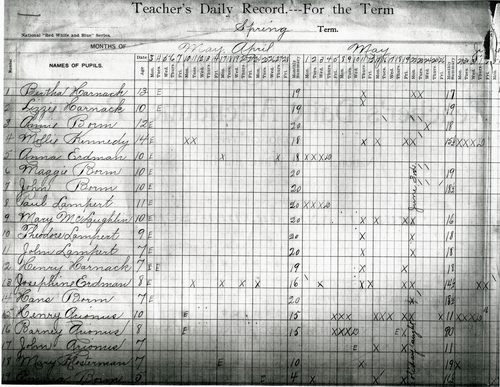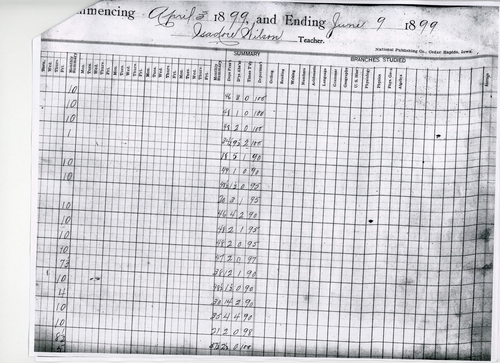
|
Remsen No. 6 School Daze Memories from former students and teachers!
|

|
Teacher's Daily Record--Spring 1899--Teacher, Isadore Wilson Page 1
Page 2
Class List from these pages: Bertha Harnack
Lizzie Harnack
Annie Borm
Mollie Kennedy
Anna Erdman
Maggie Borm
John Borm
Paul Lampert
Mary McLaughlin
Theodore Lampert
John Lampert
Henry Harnack
Josephine Erdman
Hans Borm
Henry Arionus
Barney Arionus
John Arionus
Mary Klosterman
Emma Borm
Experiences Attending an Iowa Rural School This one-room country school was located on the northwest corner of Section 20, two miles south of Remsen on graveled Highway 140. We lived on a farm 3/4ths of a mile away. Miss Krekow was my first grade teacher. After she left Miss Peters taught our school. Miss Christine Petersen was the County Superintendent. The schoolhouse was built in the middle of the acre of land set aside for rural schools. The building rested on limestone blocks, similar to those used for barn foundations at the time. Off to one side back of the schoolhouse was a combination coal and wood shed with separate boys and girls outhouses on each end. The school had no electricity since the REA (Rural Electrification Association) had not reached this area. South of the school was a shallow well with hand pump. A dense plum thicket grew along the farm fence. Only a few box elder trees grew at the edge of the property. A set of swings was in front of the school building. A wood platform formed a step into the small entry. On entering the large room, there were hooks across the back to hang coats and caps and leave lunch buckets. To the right was a table that held a large crockery jar with a push-button spigot. This was filled with water from the well. A pail, dipper, and wash basin and towel were near. On the opposite side was a large table on which sat a wind-up phonograph, song books and possibly art supplies. The heating stove sat off to one side with the stove pipe angled back to the chimney. Rows of small to large desks too up much of the room. Some of the larger desks had pull-out drawers under the seat. The drawers had a pencil tray along the side. The wood teacher’s desk was in front facing the pupil desks. The “recitation bench” was along the wall opposite the teacher’s desk. The bench I remember was built of narrow slats placed lengthwise forming the back and seat. It was large enough to hold several pupils at one time. Behind the teacher’s desk was a slate blackboard on the wall with a tray below to hold chalk and erasers. Probably some roll-up maps above. Attached to the wood frame of the blackboard was a holder with a small United States flag. On the wall above the blackboard were large framed pictures of Abraham Lincoln and George Washington. One on side of the front were library books. Most children walked to school in good weather. I started first grade when I was five. Others in our extended family were: Curtis in 3rd grade, Lloyd and Ken in 5th grade, Ruth in 7th and Don and Bob in 8th. Other families that also attended were the Borm girls, Nacke kids and later Haverkamp children. There were other families during the earlier years I was in school. Many Catholic neighbor families drove to St. Mary’s in Remsen, since it was only two miles away. One of our neighbors went to St. Mary’s school in Remsen riding in a homemade buggy pulled by a horse. (I wonder where they left the horse during the day?) The day would begin with an older boy chosen to go outside and raise the flag on the pole on the front of the school. The teacher would stand on the platform in front of the school and ring the hand bell to summon kids inside to class. All would take assigned desks, smaller kids in front and larger kids in back. The day would begin by reciting the Pledge of Allegiance. The teacher would read a chapter from the book of interest to the children. Curtis and I remember a favorite, “The Bobsy Twins”. Classes would begin. Pupils would take turns going to the recitation bench, while the rest would work on daily assignments. Music class was in the afternoon. Song books would be passed out and the teacher would wind the phonograph and put on a record. The class would sing the words from a corresponding song in the book. Curtis remembered such songs as “Old Dog Tray” and “De Camptown Races”. At Christmas all would sing popular carols. The last period on Friday afternoon was art class. We would try to copy a picture placed up in front, color pictures with crayons and cut up colored paper for various assignments. Around Christmas time we would make presents for our parents. When classes were dismissed for recess, noon hour, or days end, we didn’t all rush out at once but would be orderly directed out of our seats by turn, rise, and pass, row by row. Recess was in mid-morning and mid-afternoon. Some activities were softball, and such games as Pum, Pum, Pull Away and Andy, Andy Over. In the winter, Fox and Geese was played by tramping out a large wagon wheel shape in the snow. I don’t remember how any of these games were actually played. The little kids liked to play on the swings and any other playground equipment there. Lunch was eaten our of our lunch buckets at our desks. All our family had regular metal lunch boxes with thermos bottles snapped in the lids. I remember jelly sandwiches on homemade bread, a cookie or cake and maybe an apple. The thermos usually held milk. After lunch all were dismissed to go outside and play in good weather. Miss Peters taught us to play pinochle, a card game, if we had to stay inside. Besides keeping us occupied we had to learn how to play, use our arithmetic skills to figure out the score and numeral amount of each card. It really was educational. At days end the teacher who was also the janitor, would spread compound on the wood floor. It was sawdust mixed with oil and when swept would pick up the dirt. The teacher was also responsible for the building the fire in the stove. A supply of coat and wood was kept in the out building. The Christmas program was a special event. The parents would be invited to the program and later presented with homemade gifts by their children. All pupils had a part, memorizing a “piece”, or participating in a short skit. The front of the school was the stage. Teacher’s desk was moved to one side and a wire was tightly strung from one wall to the other. Sheets were used as curtains, hung from the wire with large safety pins. Two pupils, one of each side, could easily open and close the curtain at appropriate times. Dust storms were a weather event in 1936. I was terrified of them. This was during the drought years and occurred in spring when farmers were working the bare ground. The teacher would have us move our desks as close to the window as possible so we could still do our assignments. Parents came for the children when it was possible. Parents and children would travel to a park in Cherokee to have fun the last day of school. It’s now called Spring Lake Park. Families brought the picnic lunch and the kids played on the swings, slides and merry-go-round. I remember walking under the road (Highway 59) to the dam. Traces of the dam are still visible east of the highway bridge. A sad time I remember was my brother Lloyd passing away with a sudden illness of appendicitis. It was just before Christmas in 1936. He was in fifth grade with Ken. The schoolhouse was built on a limestone block foundation. Skunks would sneak through a hole and fight under the school. Their “perfume” would permeate the building. The directors were told and took care of the problem. A favorite game of the older kids was to play ball. Usually, Miss Peters would be the pitcher. One time the batter hit the ball and struck Miss Peters in the head. When she came to, school was dismissed and somehow she got home. I don’t remember the details, but several days later the teacher had a very black eye. The school was closed after the 1937-38 school year. Not enough pupils were left to attend. The building was sold and moved to Remsen. It ended up behind the house located on the north side of the railroad tracks. In the fall of 1938, Curtis and I attend Remsen Public School with Curt in seventh and I in fifth. We only attended two years and then joined the rest at Le Mars. The rest of the family had to go to Le Mars High School, after graduating from 8th grade. Ken was in 9th, Ruth in 11th and Bob and Don in 12th. We must have had a good educational foundation in country school. Bob, after the army service, got a B.A. degree from Iowa State and later a M.A. from University of Illinois in Horticulture. Ruth attended Steven College in Missouri, later getting a B.A. from University of Minnesota, and an M.A. from Illinois State in Library Science. Ken, after the naval service, got a B.A. and M.A. from University of Iowa in Accounting. Curtis, after naval service got a B.A. from Grinnell College and an M.A. from the University of Iowa in English. I graduated from Iowa State Teacher’s College (UNI) with a B.A. in Art Education. This account of attending country school is as accurate as I can recall. It’s been interesting recalling school days, especially without electricity. But learn, we did.
|
|---|

